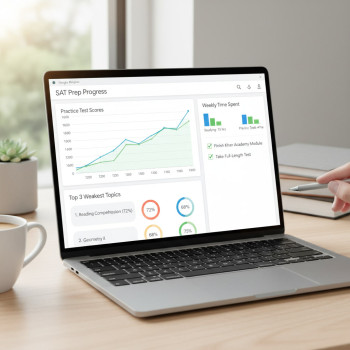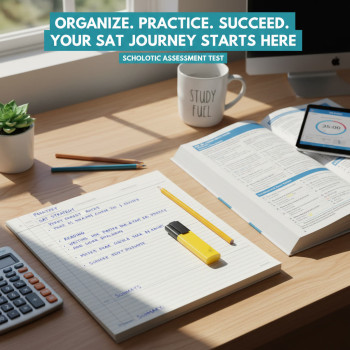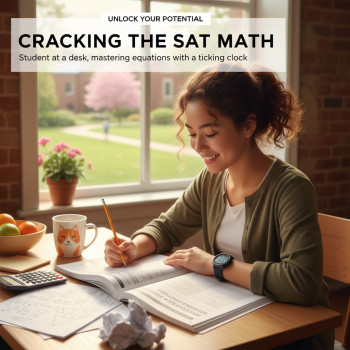Why math fluency matters more than you think on the Digital SAT
If you’ve ever sprinted through a timed practice test only to freeze on a handful of questions, you already know one truth about the Digital SAT: timing and fluency are inseparable. The Digital SAT’s structure—two adaptive modules per section, a slightly shorter overall test time, and a built-in calculator for every math question—rewards students who can think clearly, quickly, and accurately.
This isn’t about becoming a human calculator. It’s about fluent mathematical thinking: recognizing patterns, choosing efficient strategies, and keeping your mental energy steady across modules. When your fluency rises, your pacing becomes calmer, your scratchwork cleaner, and your score potential much more within reach.
What ‘math fluency’ really means for the Digital SAT
Let’s define math fluency in practical terms for SAT prep. Math fluency is the combination of:
- Automatic recall of basic arithmetic and algebraic facts (no fumbling for a multiplication table).
- Speedy recognition of common question types and structures (e.g., linear equations, systems, ratios, functions).
- Comfort with mental estimation and number sense to check answers quickly.
- Familiarity with efficient shortcuts and strategies (factoring quickly, isolating variables without algebraic overwork, sensible substitution).
- Calm, organized scratchwork that supports fast reasoning without redoing steps.
On the Digital SAT, fluency also means using the technology to your advantage: comfortable navigation of the Bluebook app, smart use of the on-screen calculator, and clean digital test habits so setup time doesn’t steal mental bandwidth.
How improved fluency translates into better timing
There are three concrete ways fluency buys you time during the test:
- Faster decoding: When you recognize a problem type right away, you skip wasted minutes exploring wrong approaches.
- Fewer re-dos: Clean, fluent work reduces careless errors that force you to re-calc or second-guess answers later.
- Better checkpointing: Fluency helps you estimate whether a question is worth 30–60 seconds or whether it’s smarter to mark and move on, protecting your overall pacing.
Put together, those benefits let you allocate time across questions in a way that maximizes your realistic scoring potential.
Digital SAT math timing: the concrete numbers
Understanding the test’s time budget makes strategy less abstract. The Digital SAT Math section is 70 minutes long, split into two equal modules. There are 44 math questions total. That gives you, on average, about 95 seconds per question—but averages disguise the reality that some questions require more time than others.
| Metric | Value |
|---|---|
| Total Math Time | 70 minutes (2 modules of 35 minutes) |
| Number of Math Questions | 44 |
| Average Time per Question | ~95 seconds |
| Practical Target | Use ~60–75 sec for easy-medium; mark and move for hard items if over 120 sec |
Those averages are a starting point. With fluency, many questions—especially the straightforward ones—should take closer to 45–70 seconds each, leaving buffer time for harder items or for review.
Five fluency-building habits that improve timing
Speed doesn’t come from rushing—it comes from habits that make your thinking more efficient. Here are five habits to incorporate into daily practice.
1) Master core facts so they’re automatic
Spend short, focused sessions to drill core number facts: fractional equivalences, squares and square roots to at least 15^2, basic powers, common factor pairs, and algebraic simplifications (distributive property, factoring common terms). Ten minutes a day of dedicated fact work beats an hour of random practice once a week.
2) Learn 8–12 go-to strategies and practice them
Strategies like plugging in answers, plugging in numbers, working backwards, and smart estimation are disproportionately helpful. Practice each strategy until you can spot the right moment to use it during a timed set.
- Plugging in answers is powerful on multiple-choice (if offered) or for verifying choices.
- Backsolving (start from the answer) quickly rules in the correct option sometimes faster than algebra.
- Estimation helps you eliminate clearly wrong answers in seconds without full calculation.
3) Emphasize mental math and efficient calculator use
The Digital SAT allows a calculator on most math questions, but relying on it for every small step slows you down. Practice mental division and multiplication shortcuts, and learn the calculator keystrokes that save time (e.g., memory functions, parentheses use). On-screen calculators may feel slightly different—include some Bluebook-style practice so the tool becomes invisible during testing.
4) Build pattern recognition with micro-practice
Instead of always doing full practice tests, do 10–15 minute micro-sessions focused on a specific pattern: systems of equations, quadratic behavior, function transformations, or word problems about rates. Micro-practice sharpens recognition so you spend less time figuring out what a problem is asking.
5) Review errors with a focus on process, not only answers
When you miss a problem, don’t just note the right answer. Rework it slowly to identify whether the error came from a conceptual gap, a procedural slip, or a careless arithmetic mistake. Then, add a 3–5 minute targeted drill aimed at that root cause. Repeatedly fixing the same procedural error wastes far more time during the real test than drilling to eliminate it during practice.
Practical pacing plans based on fluency level
Not all students start at the same fluency level. Below are three pacing templates you can adapt. Time goals assume you built fluency with the habits above.
| Fluency Level | Target per Easy/Medium Question | Target per Hard Question | Strategy |
|---|---|---|---|
| High | 45–60 sec | 90–120 sec | Work steadily; flag only truly unfamiliar items; use spare time to review flagged ones. |
| Moderate | 60–75 sec | 100–130 sec | Flag medium-hard items earlier; return with 10 min at end of module. |
| Developing | 75–95 sec | 120–150+ sec | Use aggressive flag-and-move strategy; secure easy points first; prioritize accuracy on easy items. |
Example walkthrough: turning a 3-minute struggle into 60 seconds
Here’s a real-world sequence showing how fluency shortens a problem’s timeline.
Problem sketch: A word problem asks for the rate at which two taps fill a tank together, given individual time-to-fill numbers. A student spends three minutes writing equations, making algebra mistakes, and redoing arithmetic.
Fluent approach (60 seconds):
- Recognize this as a combined work/rate problem (5 seconds).
- Translate to rate form: tap A = 1/a per hour, tap B = 1/b per hour, combined = 1/a + 1/b (10 seconds).
- Plug in given numbers and solve with fraction simplification or smart calculator use (30–40 seconds).
- Confirm answer by sanity-checking: combined rate should be faster than either alone (makes sense) (5–10 seconds).
The difference wasn’t magical. It came from pattern recognition, a practiced translation into the right rate framework, and a quick sanity check to avoid rework.
How to structure a weekly practice plan that builds fluency
Consistency trumps marathon sessions. Below is a practical four-week block you can repeat and adapt.
- Daily (30–60 minutes): 10 minutes of fact drills; 20–40 minutes of targeted practice (micro-sessions on one problem type).
- Twice weekly (60–90 minutes): Mix of medium-length timed sets (20–30 questions) focused on specific modules like algebra or geometry.
- Weekly (3–4 hours on weekend): Full practice module under realistic timing to build endurance. Immediately review errors with the 3-step fix (identify cause → drill 3–5 similar problems → re-test yourself on them).
- Monthly: Take a full-length adaptive practice test in Bluebook to simulate device feel and adaptive behavior.
This rhythm blends micro-skill building with realistic pacing practice, which is how fluency grows without burning out.
Using practice data to refine pacing (make every minute count)
Practice without reflection is noise. Track three metrics: average time per question by type, percentage correct by type, and number of questions you flagged per module. After each full practice module, create a simple table to see where time leaks occur.
| Question Type | Avg Time | % Correct | Action |
|---|---|---|---|
| Linear equations | 50 sec | 92% | Maintain practice; occasional speed drills |
| Word problems (rates) | 95 sec | 78% | Targeted micro-practice + strategy drills |
| Geometry | 80 sec | 85% | Diagram practice + mental-picture drills |
From this simple snapshot, you can see where to cut time (e.g., linear equations are fast) and where to invest effort (word problems). That targeted work compounds quickly: a 10–15% time reduction on several common types nets large gains on test day.
Test-day habits that preserve fluency and timing
On the Digital SAT, pacing wins when you preserve clear thinking. Here are concrete habits to use on test day:
- Start each module by skimming all question stems for quick wins—grab any obviously easy ones first.
- Use the test’s flagging tool liberally: if you’re over your target time on a question, mark and move on.
- Leave a small buffer of time at the end of each module to revisit flagged items—don’t exhaust your buffer on one question.
- When you return to a flagged item, rapidly decide: can you salvage points with a 60-second trick (plug-in, estimation)? If not, accept a guess and move to the next flagged item.
- Keep your scratchwork organized: a simple column for calculations and a small area for diagramming saves time you’d otherwise waste reading messy notes.
Why quality tutoring speeds fluency gains—and what to expect
Tailored instruction accelerates fluency by focusing your practice on the exact patterns where you’re slow. A strong tutor helps you:
- Diagnose precise bottlenecks—are you slow because of number facts, translation errors, or noisy scratchwork?
- Practice targeted drills that replace slow habits with faster ones.
- Simulate pacing strategies under pressure while providing immediate feedback on mistakes.
For many students, Sparkl’s personalized tutoring can be a natural fit here: 1-on-1 guidance helps you convert repeated errors into durable habits, tailored study plans ensure you practice the right problems, and AI-driven insights can highlight tiny timing leaks you might miss on your own. When tutoring fits your learning style, it speeds progress and helps you retain fluency under test-day pressure.
Common myths about speed and accuracy
Myth #1: “Faster means sloppier.” Not necessarily. Speed rooted in fluency usually increases accuracy because it reduces cognitive load and hesitation. The trick is to train for accurate speed, not careless speed.
Myth #2: “You must answer every question to score well.” Smart pacing sometimes means leaving hard questions for later. Because the Digital SAT is adaptive, finishing earlier on manageable questions to secure points often outranks spending precious minutes on one impossible problem.
Myth #3: “Calculator use always saves time.” A calculator can speed complex arithmetic but slow you for simple manipulations. Know when to compute mentally and when to use the calculator efficiently.
Quick drills you can do in 10 minutes today
Try these short drills to practice fluency without a huge time commitment.
- Flash fact sprint: 2 minutes of squared numbers and 2-minute fraction-decimal conversions.
- Strategy round: 5 problems where you must use either plugging in or backsolving—practice selecting the most efficient method for each.
- One-minute estimation: look at five answer sets and eliminate the impossible ones using quick magnitude checks.
Measuring progress: what improvement looks like
Fluency gains show up in a few measurable ways:
- Decreased average time per question on repeated practice sets.
- Lower variance in question times—you stop having big spikes where you get stuck for minutes.
- Higher corrected percentage for questions you previously flagged as slow types.
- Greater margin at the end of modules to review flagged items.
Track these metrics for four weeks and look for steady change. Small improvements compound: shaving 10–15 seconds off several question types adds up to meaningful extra review time on test day.
Putting it all together: a realistic test-day script
Here’s a short script you can mentally rehearse before test day. It keeps the focus tight and the pacing strategic:
- Module start: skim all question stems (30–60 sec).
- First pass: complete all easy-medium items, flag medium-hard items (use 60–75 sec targets per problem).
- Second pass: tackle flagged items with 90–120 sec limits—use substitution or estimation first.
- Final 5–8 minutes: answer remaining flagged items quickly or guess intelligently based on elimination.
Rehearsing this script turns an abstract timing plan into an automatic routine on test day.
Parting advice: patience, not panic
Improving fluency is a patient craft. A week of frantic timed tests won’t create lasting speed. Steady, focused practice that corrects the root causes of slowness will. Keep sessions short and purposeful, measure the right metrics, and let small wins accumulate.
If you want support building a plan tailored to your exact timing profile, consider combining personalized tutoring (such as Sparkl’s tailored study plans and 1-on-1 coaching) with regular Bluebook simulation practice. That blended approach often yields the fastest, most reliable improvements—because it pairs human insight with data-driven practice.
Final checklist: fluency-ready before test day
- Have you drilled core facts until they’re automatic?
- Can you spot and name the five most common math templates you struggle with?
- Do you have a 10-minute daily micro-practice routine?
- Have you practiced with the Bluebook app to eliminate tech surprises?
- Do you leave time at the end of modules to review flagged items?
Answering yes to these questions means you’re not leaving timing to chance. You’re building fluency—real speed that preserves accuracy and gives you a calm, confident edge on the Digital SAT. Good luck: you’ve got this, one practiced step at a time.
















No Comments
Leave a comment Cancel